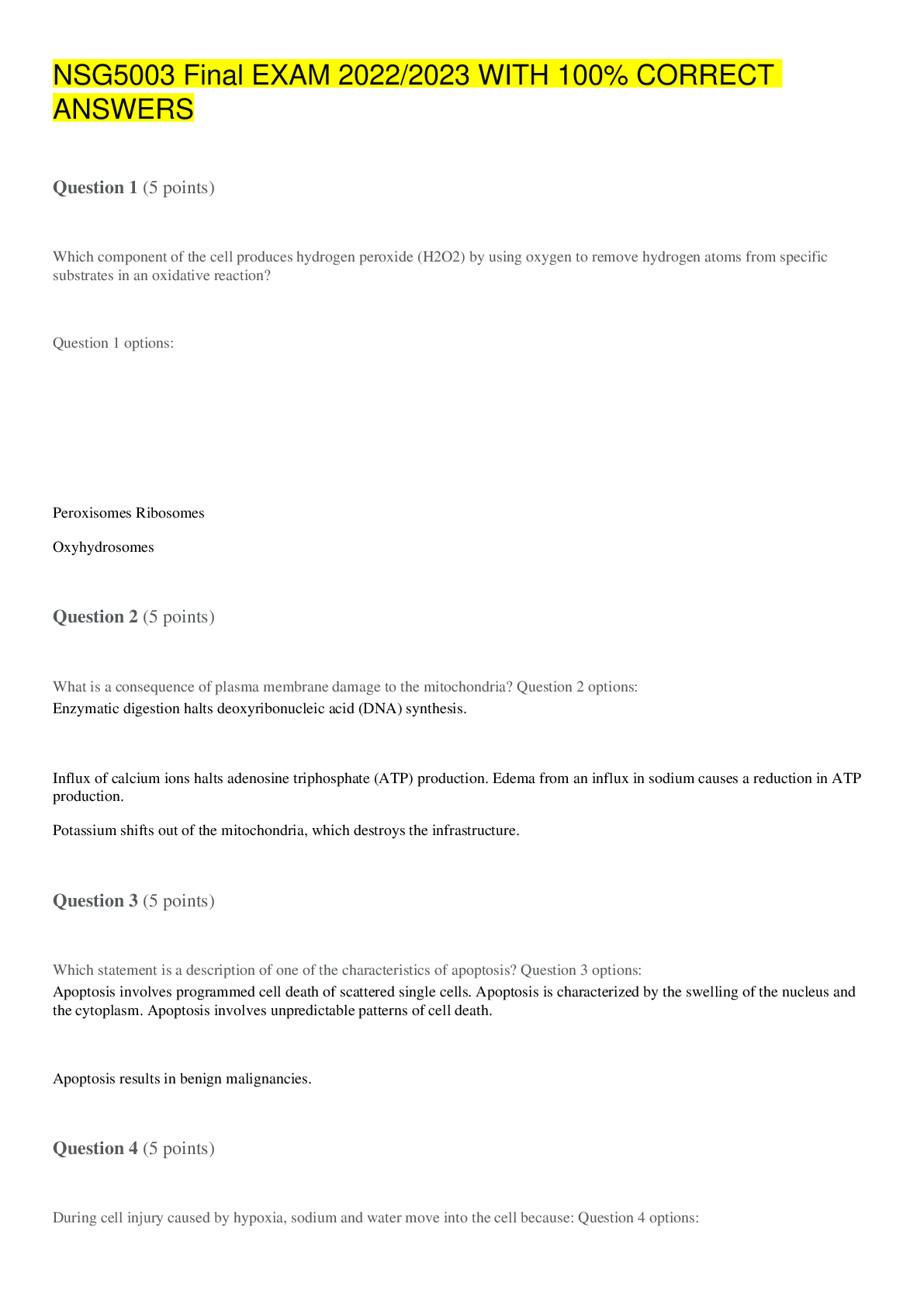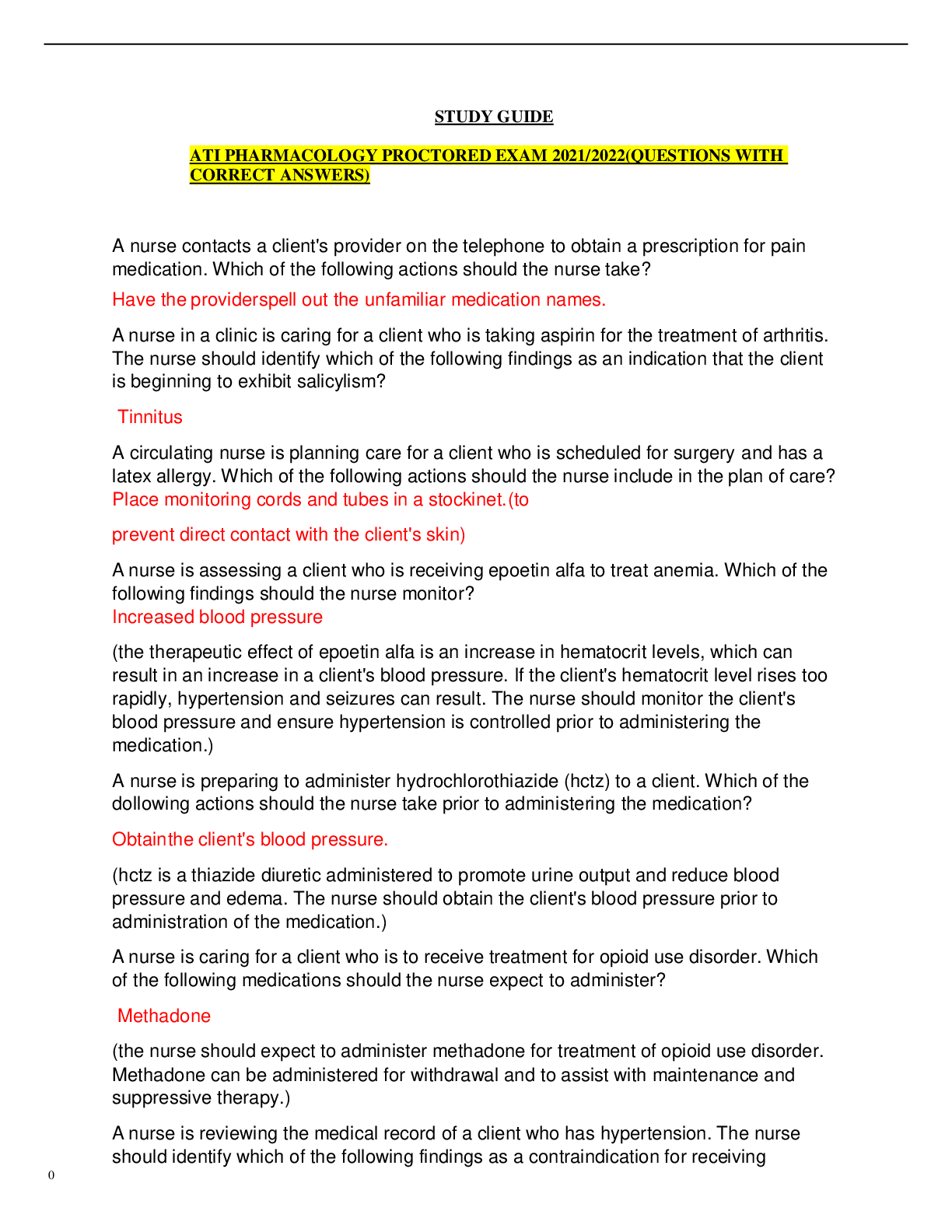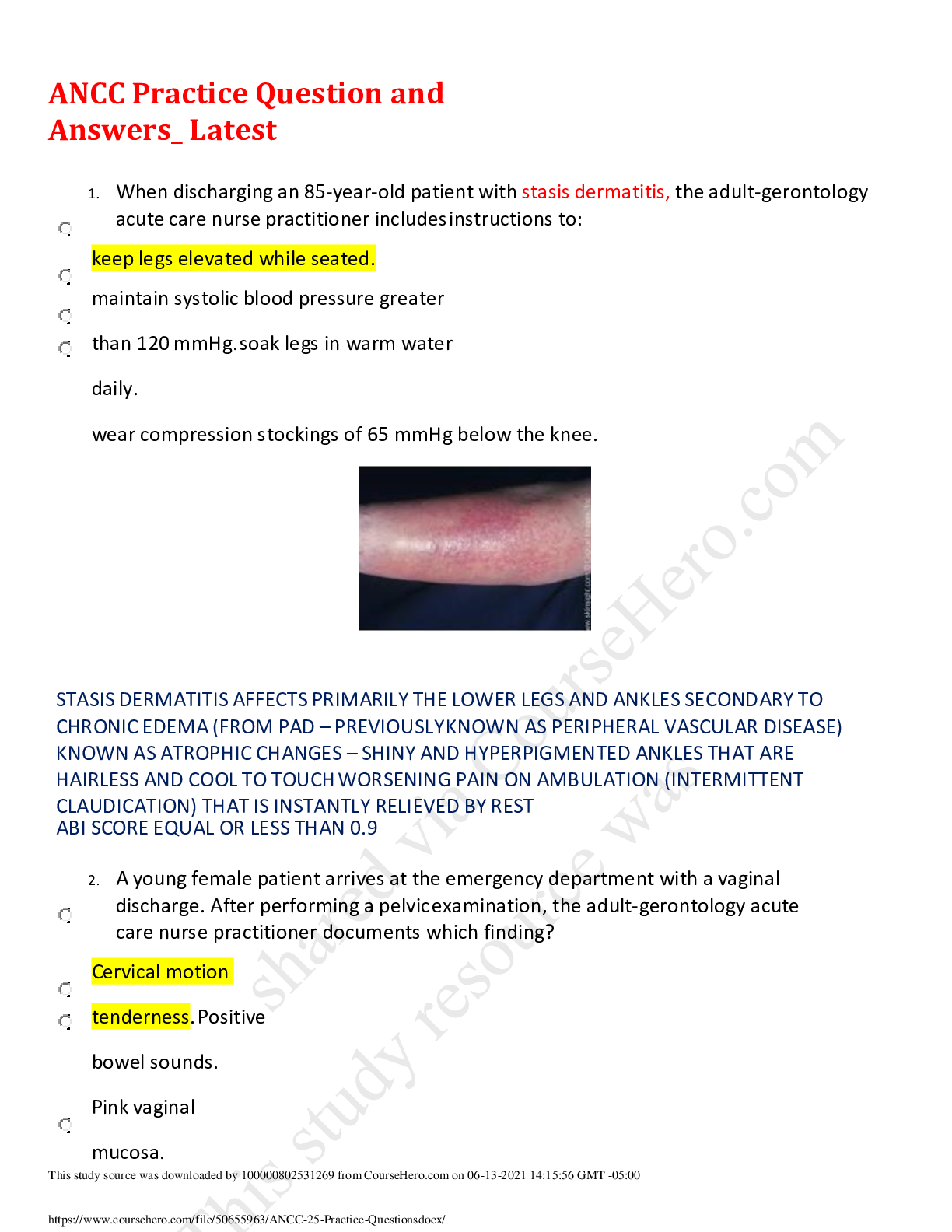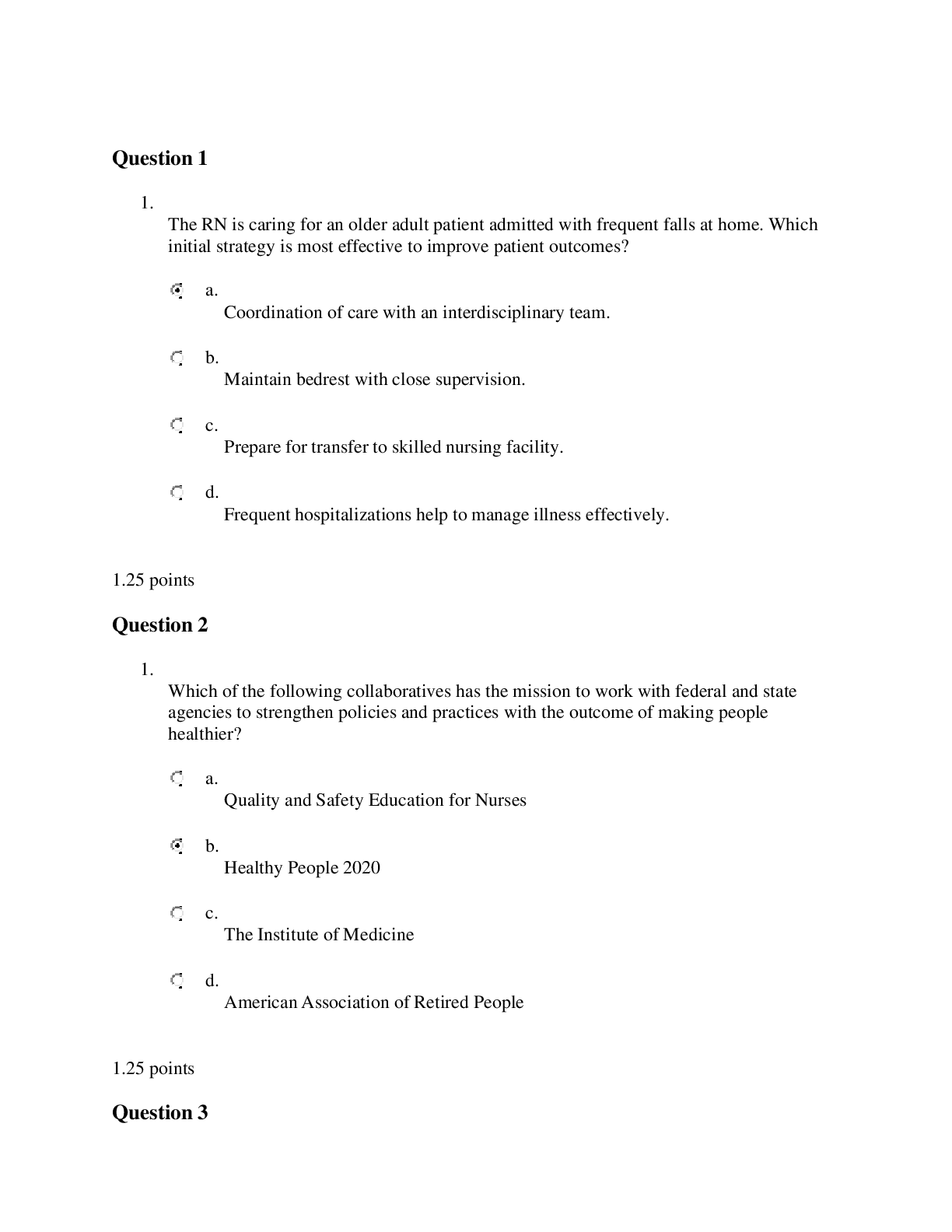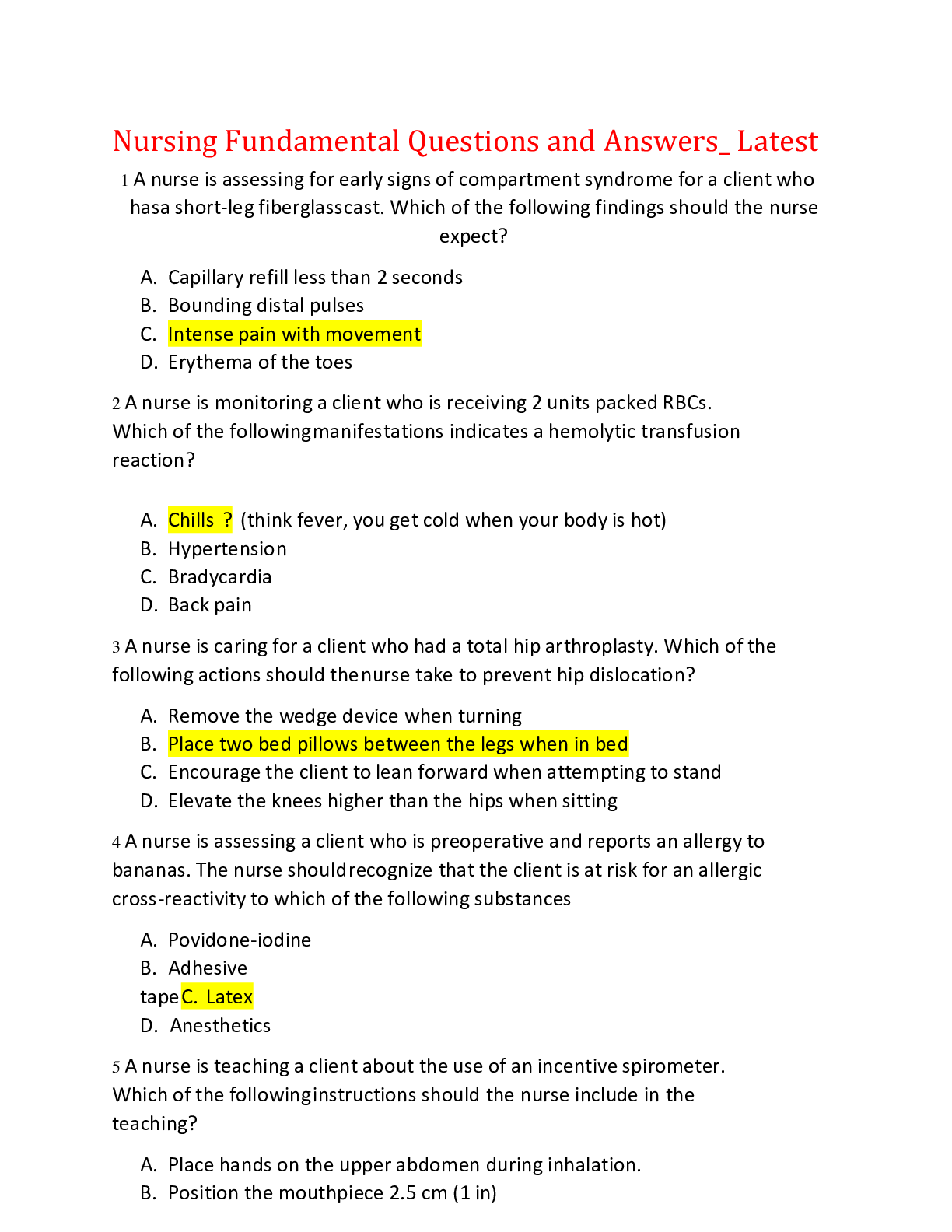*NURSING > EXAM > NURSING NUR200 Quizs Week3 and Week9 Questions and Answers_ Latest,100% CORRECT (All)
NURSING NUR200 Quizs Week3 and Week9 Questions and Answers_ Latest,100% CORRECT
Document Content and Description Below
NURSING NUR200 Quizs Week3 and Week9 Questions and Answers_ Latest Week 9 Quiz Which of the following statements are true? Selected Answer: d. A & B Answers: a. First-generation ... (typical) antipsychotics are associated with a higher incidence of EPS. b. Second-generation (atypical) antipsychotics are associated with a higher risk of metabolic side effects. c. There is evidence that atypical antipsychotics are significantly more effective than typical antipsychotics in the treatment of cognitive symptoms associated with schizophrenia. d. A & B e. A, B, and C Cindy is a 55-year-old patient who presents with symptoms consistent with Generalized anxiety disorder. The patient has an unremarkable social history other than she consumes two or three glasses of wine per night. Which of the following would be an appropriate therapy to start this patient on? Selected Answer: b. Escitalopram 10mg daily Answers: a. Xanax 0.25mg BID PRN Anxiety b. Escitalopram 10mg daily c. Buspirone 10mg BID d. Aripiprazole 10mg daily • Question 3 Richard is a 54-year-old male who suffers from schizophrenia. After exhausting various medication options, you have decided to start him on Clozapine. Which of the statements below is true regarding Clozapine? Selected Answer: d. A & B Answers: a. Regular blood monitoring must be performed to monitor for neutropenia. b. Clozapine can only be filled by a pharmacy that participates in the REMS program. c. Bradycardia is a common side effect of Clozapine. d. A & B e. All of the above Jordyn is a 27-year-old patient who presents to the clinic with GAD. She is 30 weeks pregnant and has been well controlled on a regimen of sertraline 50mg daily. Jordyn says that "about once or twice a week my husband really gets on my nerves and I can't take it." She is opposed to having the sertraline dose increased due to the risk of further weight gain. You have decided to prescribe the patient a short-term course of benzodiazepines for breakthrough anxiety. Which of the following is the LEAST appropriate benzodiazepines to prescribe to this patient? Selected Answer: b. alprazola m Answers: a. diazepam b. alprazola m c. clonazepa m d. lorazepa m Jason is a 6-year-old child whose mother presents to the clinic with him. The mother says that “he's not himself lately." After a thorough workup, you diagnose the patient as having GAD. Which of the following medications would be the LEAST appropriate to prescribe to this child? Selected Answer: b. Paroxetin e Answers: a. Sertraline b. Paroxetin e c. Venlafaxi ne d. Buspirone John is a 41-year old-patient who presents to the clinic with diarrhea, fatigue, and recently has been having tremors. He was diagnosed 19 years ago with bipolar disorder and is currently managed on Lithium 300mg BID. As the PMHNP, you decide to order a lithium level that comes back at 2.3mmol/l. What is the most appropriate course of action? Selected Answer: c. Tell John he needs to go to the hospital and call an ambulance to bring him. Answers: a. Investigate other differential diagnoses for his symptoms. b. Tell John to skip his next four Lithium doses and resume therapy. c. Tell John he needs to go to the hospital and call an ambulance to bring him. d. Prescribe loperamide to treat the diarrhea and ropinirole to treat the tremors Mark is a 46-year-old male with treatment-resistant depression. He has tried various medications, including SSRIs, SNRI, and TCAs. You have decided to initiate therapy with phenelzine. Which of the following must the PMHNP take into consideration when initiating therapy with phenelzine? Selected Answer: d. A & B Answers: a. There is a minimum 7-day washout period when switching from another antidepressant to phenelzine. b. Patient must be counseled on dietary restrictions. c. MAOIs may be given as an adjunctive therapy with SSRIs. d. A & B e. All of the above Rebecca is a 32-year-old female who was recently prescribed escitalopram for MDD. She presents to the clinic today complaining of diaphoresis, tachycardia, and confusion. The differential diagnosis for this patient, based on the symptoms presenting, is: Selected Answer: d. Serotonin syndrome Answers: a. Panic disorder b. Gastroenteritis c. Abnormal gait d. Serotonin syndrome The patient in the previous question states, "I can't even last 1 more day without feeling like my insides are going to explode with anxiety." The most appropriate course of action would be: Selected Answer: b. Prescribe a short-term course of low dose benzodiazepine, such as alprazolam. Answers: a. Inform the patient to try yoga or other natural remedies until the vortioxetine takes effect. b. Prescribe a short-term course of low dose benzodiazepine, such as alprazolam. c. Prescribe an SNRI, such as venlafaxine, in addition to the vortioxetine. d. Recommend in-patient mental health for the foreseeable future. Thomas is a 28-year-old male who presents to the clinic with signs and symptoms consistent with MDD. He is concerned about starting antidepressant therapy, however, because one of his friends recently experienced erectile dysfunction when he was put on an antidepressant. Which of the following would be the most appropriate antidepressant to start Thomas on? Selected Answer: a. Vilazodo ne Answers: a. Vilazodo ne b. Sertralin e c. Paroxetin e d. Citalopra m Amber is a 26-year-old female who presents to the clinic 6 weeks postpartum. The patient states that she has been "feeling down" since the birth of her son. She is currently breastfeeding her infant. You diagnose the patient with Postpartum depression. Which of the following is the LEAST appropriate option in treating her PPD? Selected Answer: b. escitalopra m Answers: a. paroxetine b. escitalopra m c. citalopram d. sertraline Stephanie is a 36-year-old female who presents to the clinic with a history of anxiety. Social history is unremarkable. For the last 4 years, she has been well controlled on paroxetine, however she feels “it just doesn't work anymore.” You have decided to change her medication regimen to vortioxetine 5mg, titrating up to a max dose of 20mg per day based on tolerability. The patient asks, “When can I expect this to start kicking in?” The best response is: Selected Answer: c. 3 or 4 weeks Answers: a. 3 or 4 days b. 1 or 2 weeks c. 3 or 4 weeks d. 10 weeks Martin is a 92-year-old male who presents to the clinic with signs/symptoms consistent with MDD. The patient suffers from glaucoma and just recently underwent surgery for a cataract. Which of the following is the LEAST appropriate course of therapy when treating the MDD? Selected Answer: b. amitriptyli ne Answers: a. sertraline b. amitriptyli ne c. duloxetine d. vilazodone Mirza is a 75-year-old patient with a long history of schizophrenia. During the past 5 years, she has shown significant cognitive decline consistent with dementia. The patient has been well controlled on a regimen of risperidone 1mg BID. As the PMHNP, the most appropriate course of action for this patient is: Selected Answer: b. Discontinue risperidone and prescribe a long-acting injectable such as Invega Sustenna. Answers: a. Increase the risperidone to 1mg QAM, 2mg QPM b. Discontinue risperidone and prescribe a long-acting injectable such as Invega Sustenna. c. Discontinue risperidone and initiate therapy with clozapine. d. Augment the patient's risperidone with brexpiprazole. Which of the following medications, when given intramuscularly, is most likely to cause severe postural hypotension? Selected Answer: d. chlorpromazi ne Answers: a. haloperidol b. lorazepam c. benztropine d. chlorpromazi ne Sam is a 48-year-old male who presents to the clinic with signs and symptoms consistent with GAD & MDD. Which of the following medications would be the LEAST appropriate choice when initiating pharmacotherapy? Selected Answer: d. buproprio n Answers: a. duloxetin e b. sertraline c. mirtazapi ne d. buproprio n Melvin is an 89-year-old male who presents to the clinic with signs/symptoms consistent with MDD. Which of the following would be the LEAST appropriate medication to prescribe to this elderly patient? Selected Answer: b. amitriptyli ne Answers: a. nortriptylin e b. amitriptyli ne c. desipramin e d. trazodone Steve is a 35-year-old male who presents to the primary care office complaining of anxiety secondary to quitting smoking cold turkey 2 weeks ago. The patient has a 14- year history of smoking two packs per day. The patient has an unremarkable social history other than a recent divorce from his wife, Brittany. Which of the following would be the LEAST effective medication to treat Steve's anxiety? Selected Answer: d. Alprazola m Answers: a. Buproprio n b. Sertraline c. Vareniclin e d. Alprazola m Jane is a 17-year-old patient who presents to the office with signs consistent with schizophrenia. She states multiple times that she is concerned about gaining weight, as she has the perfect prom dress picked out and she finally got a date. Which of the following is the least appropriate choice to prescribe Jane? Selected Answer: b. Olanzapine Answers: a. Aripiprazole b. Olanzapine c. Haloperidol d. Brexpiprazo le Earle is an 86-year-old patient who presents to the hospital with a Community Acquired Pneumonia. During stay, you notice that the patient often seems agitated. He suffers from cognitive decline and currently takes no mental health medications. Treatment for the CAP include ceftriaxone and azithromycin. The LEAST appropriate medication to treat Earle's anxiety is: Selected Answer: c. citalopra m Answers: a. sertraline b. duloxetin e Week 3 Quiz c. citalopra m d. venlafaxi ne Introducing adherence in facilitating treatment goals is something that would be necessary in a patient who has previously displayed nonadherence patterns. Selected Answer: A. True Answers: A. True B. False Response Feedback: It is introduced as early as possible in treatment to mitigate the risks associated with nonadherence. The human brain is subcategorized into four major structures. These structures include the cerebral cortex, brainstem, subcortical structures, and the cerebellum. Of these major categories, which one houses the area of the brain that has been found in some neuropathological studies of patients with schizophrenia to be of smaller size? Selected Answer: C. Subcortical structures Answers: A. Cerebral cortex B. Brainstem C. Subcortical structures Response Feedback: D. Cerebellum The area of the brain in question is part of the thalamus, which is located in the subcortical structures. The other options are incorrect, geographically speaking. When dopamine (subtype 2) receptors are blocked in this pathway (system), it is evident by EPS. Selected Answer: C. Nigrostriatal Answers: A. Mesocortical B. Tuberoinfundibul ar Response Feedback: C. Nigrostriatal D. Mesolimbic D is associated with positive symptoms in schizophrenia, B is associated with lactation, A is associated with affect. Which neurotransmitter is considered the major excitatory neurotransmitter? Selected Answer: C. Glutama te Answers: A. Glycine B. GABA C. Glutama te Response Feedback: D. Serotoni n A and B are inhibitory, and D is involved in mood and sleep. Serotonin (5HT) is a neurotransmitter associated with mood, sleep, and psychosis. There are several serotonin receptors all over the human body. A unique aspect of the second generation antipsychotics is their ability to block 5HT2a receptors. What is the effect of this inhibition? Selected Answer: A. Stabilizes dopamine concentrations in the CNS Answers: A. Stabilizes dopamine concentrations in the CNS B. Induces anxiety C. Causes hallucinations D. Reduces platelet function Response Feedback: B represents antagonism of 5HT1a, C represents a 5HT2a agonist, and D represents what happens when you inhibit SERT. Which of the following consists of all the known major neurotransmitters that are relevant in psychiatry? Selected Answer: B. glutamate, GABA, dopamine, norepinephrine, serotonin, acetylcholine, histamine, endogenous opioids, steroids, cannabinoids, nitric oxide Answers: A. glutamate, GABA, dopamine, serotonin, norepinephrine, histamine, steroids, nitric oxide B. glutamate, GABA, dopamine, norepinephrine, serotonin, acetylcholine, Response Feedback: histamine, endogenous opioids, steroids, cannabinoids, nitric oxide C. glutamate, GABA, dopamine, serotonin, acetylcholine, endogenous opioids, nitric oxide, cannabinoids, steroids D. glutamate, GABA, dopamine, serotonin, norepinephrine, endogenous opioids, steroids, histamine, nitric oxide all the other options are missing neurotransmitters considered important in psychiatry Upon blocking a Serotonin reuptake pump, what happens in the synaptic cleft and on the post synaptic cell membrane? Selected Answer: B. The result will be an increase in the available Serotonin in the synaptic cleft causing the post synaptic neuron to reduce the number of Serotonin receptors. Answers: A. The result will be an increase in available Serotonin in the synaptic cleft causing the post synaptic cell to increase the number of Serotonin receptors. B. The result will be an increase in the available Serotonin in the synaptic cleft causing the post synaptic neuron to reduce the number of Serotonin receptors. C. The result will be an increase in Serotonin in the synaptic cleft resulting in an increase in reuptake pumps on the presynaptic neuron. D. The result will be an increase in Serotonin in the synaptic cleft resulting in a decrease in reuptake pumps on the pre-synaptic neuron. Response Feedback: A, C, and D are misrepresentations of what occurs when you increase Serotonin in the synaptic cleft. There is no effect on the pre-synaptic neuron, and the increases in Serotonin result in a reduction of receptor concentration on the post-synaptic neuron. Treatment adherence is affected by several different factors. Clinical factors include mood, anxiety, psychosis, and substance misuse. There are also patient factors such as knowledge, attitude, and beliefs; economic and racial/ethnic disparities, and clinical encounters. A patient who presents hopeless, with decreased energy, and poor concentration is affected by which factor? Selected Answer: D. Mood Answers: A. Substance misuse B. Knowledge deficits C. Attitude ad belief system D. Mood Response Feedback: These are signs of an altered mood. Receptors trigger one of two effector pathways resulting in changes in neuronal activity. These changes will, ultimately, effect gene expression. Which effector pathway is characterized by ion flux through transmitter-activated channels resulting in an altered membrane potential and neuronal activity? Selected Answer: D. NMDA glutamate receptor pathways Answers: A. Slow effector pathways B. Modulated effector pathways C. Rapid effector pathways D. NMDA glutamate receptor pathways Response Feedback: Answer B is fictitious, D is a type of rapid effector pathway, and A represents G-protein coupled receptors. Of the components of patient-focused interventions to enhance adherence, which component includes the following strategies: adaptive thinking, use of cues, and support? Selected Answer: B. Skills Answers: A. Motivatio n Response Feedback: B. Skills C. Logistics D. Educatio n Skills include adaptive thinking, problem solving, use of cues, and support. G-protein coupled receptors are targets for several psychiatric medications. Given what we know about these receptors, what is the ultimate result we will see when one of them is activated in a way that would potentiate an action? Selected Answer: C. Modification of gene expression Answers: A. Intracellular activation of second messengers B. Protein phosphorylation C. Modification of gene expression Response Feedback: A and B are both steps in the activities seen leading up to modification of gene expression. A patient arrives in the ED via EMS having a grand mal seizure. The ED physician instructs the RN to give 10 milligrams of Diazepam IV X1 dose STAT. The patient’s seizure breaks within 2 minutes of the Diazepam being administered. The mechanism by which this medication causes rapid resolution of seizure activity is via which receptor type (effector pathway/receptor subtype)? Selected Answer: D. Rapid effector pathway/ion channel Answers: A. Slow effector pathways/G-protein coupled receptor B. Slow effector pathway/ion channel C. Rapid effector pathways/G-protein coupled receptor D. Rapid effector pathway/ion channel Response Feedback: Options B and C are mismatched, and Option A shows effects days to weeks after activation. 1Neurons are classified in several different ways. From the following statements, select which ones are true. i. The two structural classifications are projection neurons and local inter- neurons. ii. Function classifications are made up of two subcategories: excitatory and inhibitory. iii. Histological classification includes bipolar, unipolar, and multipolar. iv. Classifications using a combination of structural, functional, and neurotransmitter type provide the most robust and useful description. v. Classification by neurotransmitter type alone provides the most useful description. Selected Answer: E. I, III, and IV Answers: A. I only B. III only C. I, II, and V only Response Feedback: D. I, II, III, IV, and V E. I, III, and IV Statement II would need to include modulatory function to be correct, and Statement V does not include structural and functional classification systems. Glia cells play a supportive role to the neuron. A few of the functions of the glial cells include providing nutrition, maintaining homeostasis, stabilizing synapses, and myelinating axons. The glial cells are categorized as microglia and macroglia. Of these two cell types, which one plays an active and critical role in glutamatergic neurotransmission by providing a co-agonist required for glutamate receptor function? Selected Answer: B. macrogli al Answers: A. microgli al Response Feedback: B. macrogli al Microglial cells are small, phagocytic cells related to peripheral macrophages. Neurotransmission is unidirectional insofar as chemical and electrical conduction is concerned within the individual neuron. Of the following descriptions, which best characterizes the order of neurotransmitter/receptor interaction that results in an electrical signal impulse and the release of another neurotransmitter for interaction in the synaptic cleft (signal conduction through a neuron)? Selected Answer: C. Dendrites, Cell body, Axon, Axon terminals Answers: A. Cell body, dendrites, Axon, Axon terminals Response Feedback: B. Dendrites, Axon, Cell body, Axon, Axon terminals C. Dendrites, Cell body, Axon, Axon terminals D. Axon terminals, Axon, Cell body, Dendrites All of the other options are mis-sequenced in signal conduction. If a patient admits to taking his medication every other day (instead of daily, as prescribed), a potential concern would be: Selected Answer: A. Sufficient understanding or acceptance of the illness Answers: A. Sufficient understanding or acceptance of the illness B. Abuse of the medication C. Expense D. Is the desired effect recognized at a lower daily dose? Response Feedback: A represents a patient taking his medication sporadically, B represents a patient taking too much medication, and D represents a patient taking a lower-than-prescribed dose but daily Motivation is a component of patient-focused interventions to enhance adherence. Based on the transtheoretical model, readiness to change can fluctuate across five stages. Which stage is represented by the patient who is aware that a problem exists and, while seriously thinking about overcoming it, has not yet committed to a plan of action? Selected Answer: C. Contemplati on Answers: A. Preparation B. Action C. Contemplati on D. Maintenanc e Neurotransmitters are defined by four essential characteristics. These are: Selected Answer: E. A, C, and D only Answers: A. Neurotransmitters are synthesized within presynaptic neurons. B. Depolarization of a neuron results in the release of a neurotransmitter, which exerts a multitude of actions on the postsynaptic neuron. C. Their action on postsynaptic neurons can be replicated by administering a drug that mimics the activity of the endogenous neurotransmitter. D. Their action in the synaptic cleft is terminated by a specific action. E. A, C, and D only Response Feedback: Answer B should read a “discrete” (not multitude) action on the post synaptic neuron. The synaptic cleft is best characterized by which of the following statements? Selected Answer: C. The synaptic cleft is an area where dendrites and axon terminals are within close proximity, allowing for the release of a neurotransmitter from a presynaptic neuron that can interact with receptors on dendritic cells of a post synaptic neuron, which is the main basis for intercellular communication of neurons. Answers: A. The synaptic cleft is the space between a single neuron’s dendrites and axon terminals in which intracellular communication occurs through the release of neurotransmitters allowing for signal conduction throughout the central nervous system. B. The synaptic cleft is the space between the cell body and axon terminals that allows for release of neurotransmitters from the presynaptic neuron for intercellular communication with an adjacent neuron (post synaptic neuron). C. The synaptic cleft is an area where dendrites and axon terminals are within close proximity, allowing for the release of a neurotransmitter from a presynaptic neuron that can interact with receptors on dendritic cells of a post synaptic neuron, which is the main basis for intercellular communication of neurons. Response Feedback: Answer A represents a neuron communicating with itself and Answer B states that the synapse is the space between the cell body (not dendrites) and axon terminals. G-protein coupled receptors are examples of what type of effector pathway? Selected Answer: A. Slow effector pathways Answers: A. Slow effector pathways B. Rapid effector pathways C. NMDA glutamate receptor pathways D. Modulated effector pathways Response Answer D is fictitious, B represents ion channel receptors, and C Feedback: is a type of rapid effector pathway. [Show More]
Last updated: 1 year ago
Preview 1 out of 33 pages
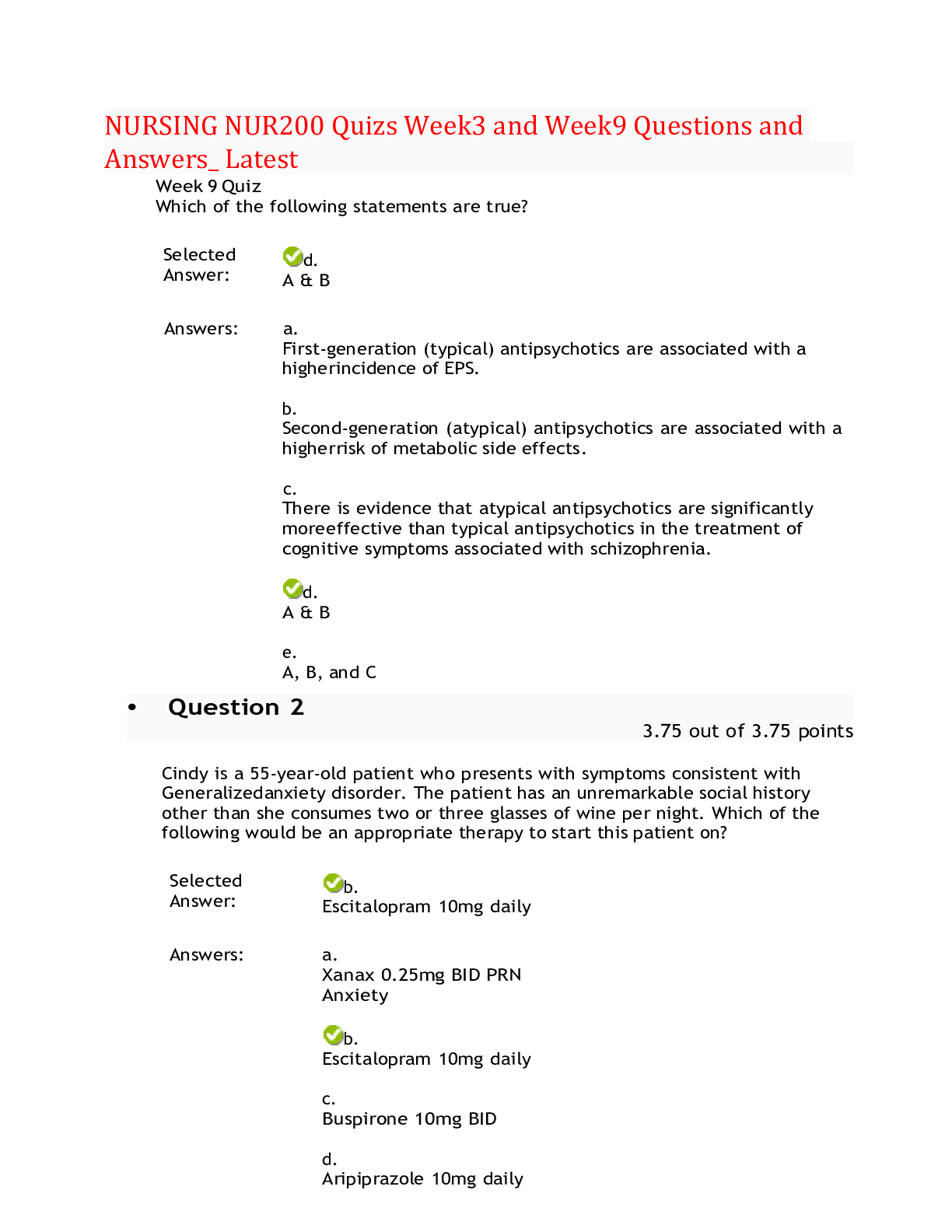
Buy this document to get the full access instantly
Instant Download Access after purchase
Add to cartInstant download
We Accept:

Reviews( 0 )
$16.00
Document information
Connected school, study & course
About the document
Uploaded On
Jul 11, 2022
Number of pages
33
Written in
Additional information
This document has been written for:
Uploaded
Jul 11, 2022
Downloads
0
Views
36














